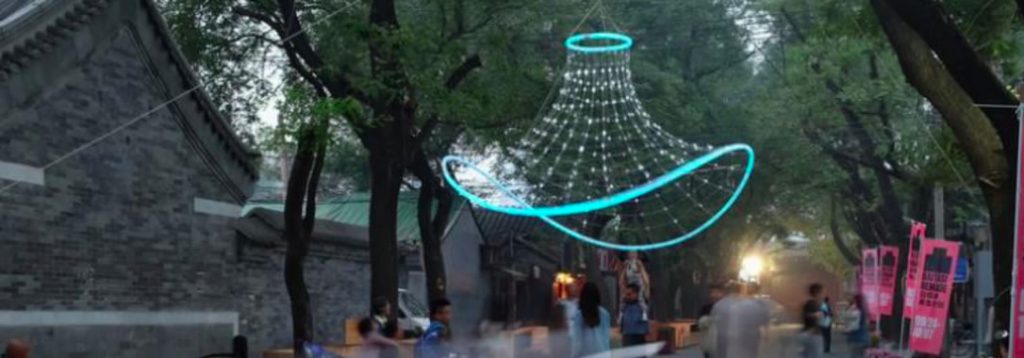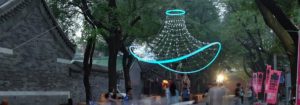Since 2011, the Beijing government has annually hosted Beijing International Design Week together with the Ministry of Education, Ministry of Science and Technology, and Ministry of Culture to drive the development of innovation and cultural industry. During its second year, Beijing Tiertime Technology Co., Ltd. started actively participating as a 3D printing technology and device supplier.
The week’s focus is Design Capital, Smart City, and Industry Integration. The Temple of the White Dagoba Regeneration Plan is one of the activities for 2015. This plan aims to explore integrating Old Beijing’s cultural protective zone with smart tech by using innovative design.
One lamp, which emits blue fluorescence and is shaped like a temple tip, is set up at the alley entrance to the Lu Xun Museum. With the black bricks, green trees and dark road lamps as the background, it highlights the distinguished temple design and remains harmonious with its surroundings.
The “ResoNet” serves to visualize the interactive energy, bringing visual enjoyment with flickering starlight to visitors immersed in the resonance of light and shadow.
How is the interaction generated? Vibration sensors at different nodes in the ResoNet mesh react to environmental factors, be it touch or the movement of objects and air. The resulting resonant frequency is analogized by LED lights. The slightest transmission of vibration causes the lights to flicker on the mesh like a passing breeze and ripple. As the tensioned mesh gradually absorbs the vibration energy, the lighting reduces sharply and finally returns to a calm state.

The ResoNet first appeared in 2007 at the largest annual outdoor artistic activity in Europe, FRED 07. It was designed and made by Chen Hailiang and Mark Tynan of the Architectural Association College in England, and their friend Shireen Hamdan. They were awarded first place for the Bright LED International Match hosted by Designboom in Italy and Gwangju Biennale Foundation in Korea, known as the Gwangju Mayor Prize.

Eight years later, Mark Tynan, Chen Hailiang, and Zhao Liquan made a ResoNet at the Temple of the White Dagoba Alley. Although the ResoNet exhibited in Beijing is consistent with the previous work in style and interaction principle, the details include some innovations.
The new ResoNet is suspended in the air to ensure convenient driving in the alley. It has also been simplified for overhead safety – the diameter is only about 4 meters. To integrate the ResoNet with the alley’s ambiance, the lamp was specially designed as a vortex dewdrop shape.
After planning and designing for one month, the team decided to cooperate with 3D printer manufacturers, including Tiertime. 3D printing was required in order to accommodate time constraints and produce a lightweight but strong base ring. After trying alternative printers, certain parts had to be remade and the base ring was finally printed in 72 sections by three Tiertime UP BOX printers running at all hours for 10 days.
“The precision of the finished parts printed on the UP BOX was high, allowing us to smoothly complete the project,” said Hailiang. “3D printing brings more possibilities to the ResoNet series. The weight problem is solved and production speed increased, so we can design different structures and shapes, and do it faster.

Shown on the left, Chen Hailiang is a member of the Royal Institute of British Architects and a graduate of the London Architectural Association College. He is one the primary designers of the Guangzhou International Financial Center and he participated in the design and construction of the 2012 Olympics Main Stadium in London. Now he acts as the Deputy Director of the Foreign Project Institute for Vanda Commercial Planning Research Academy.

Zhao Liquan, shown on the right, graduated from the London Architectural Association College. He is an architect at the Calculation Design International Research Center Project of The Architecture Design Research Academy of Tsinghua University, a leader of the English Architectural Association College for visiting colleges in Beijing and a member of the Underline Office. He participated in creating the urban research magazine, City in China, performing early research and editing.

Mark Tynan is a member of the Royal Institute of British Architects and graduate of the London Architectural Association College. He has worked at his alma mater, Cambridge College, and the Swiss Federal Institute of Technology in Zurich. He has also cooperated with top architectural firms such as Hopkins Architects and OCEAN NORTH. His architectural works are extensively used in Europe and the Middle East.


